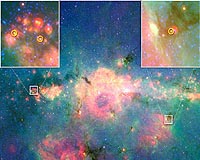 |
Pasadena CA (SPX) Jun 11, 2009 NASA's Wide-field Infrared Survey Explorer, or WISE, has been assembled and is undergoing final preparations for a planned Nov. 1 launch from Vandenberg Air Force Base, Calif. The mission will survey the entire sky at infrared wavelengths, creating a cosmic clearinghouse of hundreds of millions of objects - everything from the most luminous galaxies, to the nearest stars, to dark and potentially hazardous asteroids. The survey will be the most detailed to date in infrared light, with a sensitivity hundreds of times better than that of its predecessor, the partly NASA-funded Infrared Astronomical Satellite. "Most of the sky has never been imaged at these infrared wavelengths with this kind of sensitivity," said Edward Wright, the mission's principal investigator at UCLA. "We are sure to find many surprises." On May 17, the mission's science instrument was delivered to Ball Aerospace and Technologies Corp. in Boulder, Colo., where it was attached to the spacecraft, built by Ball. The assembled unit was then blasted by sound to simulate the effects of launch. Tests for electronic "noise" in the detectors will be performed next. The science instrument is a 40-centimeter (16-inch) telescope with four infrared cameras. A cryostat, or cooler, uses frozen hydrogen to chill the sensitive megapixel infrared detectors down to seven Kelvin (-447 degrees Fahrenheit). The instrument was built by Space Dynamics Laboratory in Logan, Utah. Among WISE's expected finds are hundreds of thousands of asteroids in our solar system's asteroid belt, and hundreds of additional asteroids that come near the Earth. Many asteroids have gone undetected because they don't reflect much visible light, but their heat makes them glow in infrared light that WISE can see. By cataloguing the objects, the mission will provide better estimates of their sizes, a critical step for assessing the risk associated with those that might impact Earth. "We know that asteroids occasionally hit Earth, and we'd like to have a better idea of how many there are and their sizes," said Amy Mainzer of NASA's Jet Propulsion Laboratory, Pasadena, the mission's deputy project scientist. "Whether they are dark or shiny, they all emit infrared light. They can't hide from WISE." The mission is also expected to find the coldest stars - dim orbs called brown dwarfs that are too small to have ignited like our Sun. Brown dwarfs are littered throughout our galaxy, but because they are so cool, they are often too faint to see in visible light. WISE's infrared detectors will pick up the glow of roughly 1,000 brown dwarfs in our galaxy, including the coldest and closest to our solar system. In fact, astronomers say the mission could find a brown dwarf closer to us than the nearest known star, Proxima Centauri, located approximately 4 light-years away. "We've been learning that brown dwarfs may have planets, so it's possible we'll find the closest planetary systems," said Peter Eisenhardt, the mission's project scientist at JPL. "We should also find many hundreds of brown dwarfs colder than 480 degrees Celsius (900 degrees Fahrenheit), a group that as of now has only nine known members." In addition, the survey will reveal the universe's most luminous galaxies seen long ago in the dusty throes of their formation, disks of planet-forming material around stars, and other cosmic goodies. The observations will guide other infrared telescopes to the most interesting objects for follow-up studies. For example, NASA's Spitzer Space Telescope, the Herschel observatory just launched by ESA with significant NASA participation, and NASA's upcoming James Webb Space Telescope will direct their gaze at objects uncovered by WISE. WISE will lift off from Vandenberg aboard a United Launch Alliance Delta II rocket. It will orbit Earth, mapping the entire sky in six months after a one-month checkout period. Its frozen hydrogen is expected to last several months longer, allowing WISE to map much of the sky a second time and see what has changed. Share This Article With Planet Earth
Related Links Wide-field Infrared Survey Explorer (WISE) Astronomy News from Skynightly.com
 Baby Stars Finally Found In Jumbled Galactic Center
Baby Stars Finally Found In Jumbled Galactic CenterPasadena CA (SPX) Jun 11, 2009 Astronomers have at last uncovered newborn stars at the frenzied center of our Milky Way galaxy. The discovery was made using the infrared vision of NASA's Spitzer Space Telescope. The heart of our spiral galaxy is cluttered with stars, dust, and gas, and at its very center, a supermassive black hole. Conditions there are harsh, with fierce stellar winds, powerful shock waves, and other ... read more |
|
| The content herein, unless otherwise known to be public domain, are Copyright 1995-2009 - SpaceDaily. AFP and UPI Wire Stories are copyright Agence France-Presse and United Press International. ESA Portal Reports are copyright European Space Agency. All NASA sourced material is public domain. Additional copyrights may apply in whole or part to other bona fide parties. Advertising does not imply endorsement,agreement or approval of any opinions, statements or information provided by SpaceDaily on any Web page published or hosted by SpaceDaily. Privacy Statement |